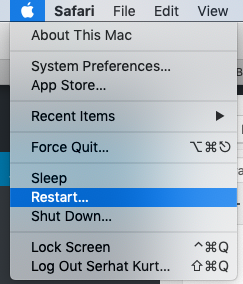Choose Another Startup Disk with the Startup Manager. To boot from a specific device. The settings stored in NVRAM remain in place even after you reboot your Mac. Problems, such as continued booting in Safe Mode, happen when one of these settings gets corrupted or changed. What you need to do is reset the NVRAM/PRAM on your Mac. To do this, follow these steps: Restart your Mac. Hold down this keyboard combination: Cmd + Option + R. You can start a Mac in Safe Mode by either shutting down and turning on or restarting your computer and immediately holding down the shift key.
Safe mode: shift. Safe mode is a way of starting up your Mac that makes sure it performs. How to Exit Safe Mode. To leave safe mode, do the following: 1. Restart your Mac without pressing keys on startup. Select “Apple menu Shut Down.” This will return you to your desktop in normal mode. Note: Exiting safe mode may take longer than booting in normal mode. Be patient and don’t interrupt the process or hard-reset your Mac.
If you’re experiencing issues with your Mac, then you can easily fix that by restarting it. I know it sounds odd, but it helps at times. However, if that doesn't fix the problem, then there are usual ways to go about solving the issue. One of the ways you can resolve them is by starting the mac in safe mode.
Not only does it help you test where the problem is, but it’s also one of the most common maintenance methods you can use with your computer.
We’re going to explain what Safe mode is, how you can boot your Mac in this state, and when you need to use it.
Also on Guiding Tech
#macos
Click here to see our macos articles page
What Is Safe Mode
Safe Mode or safe boot is a macOS diagnostic mode designed to fix several problems in your Mac.
Activating safe mode allows you to troubleshoot any problem that prevents the operating system from functioning normally. It helps you figure out the problem based on how the computer reacts to the Safe Mode environment.

While in this mode, your Mac starts without loading the additional third-party programs. So you can test whether it’s the whole system or a particular program that’s causing issues.
That means only a minimal number of preferences, system extensions, and fonts that need to run will start up with your computer so that you can isolate the issues and troubleshoot accordingly.
Safe Mode can get your computer up and running all over again whenever issues brought about by corrupt data or apps, damaged fonts, and preference files, or software installation issues arise.
You can use it to resolve any problems that keep your Mac from starting up or startup disk related issues, including apps not launching or those causing your computer to crash, freeze, or shutdown.
Also on Guiding Tech
Safe Mode vs Clean Boot: Understand the Difference and When to Use

Safe Start For Macbook
Read MoreWhat Happens When Your Mac Is in Safe Mode
Several things happen when you start your Mac in Safe Mode. Specifically, it does the following:
- You Mac loads required kernel extensions needed to run macOS.
- It verifies your startup drive by performing a directory check and attempts repairs for any issues.
- It prevents startup and login items from automatically opening at startup.
- It disables user-installed (third-party) fonts besides those found in System/Library/Fonts supplied by Apple.
- It deletes all font caches and moves them to the trash, including kernel cache and other system cache files.
- It also deletes the dynamic loader cache known for causing the blue screen freeze during startup.
- It disables or limits features such as the DVD Player, iMovie (won’t capture video), internal and/or external modems, AirPort cards (depending on the version and macOS version in use), Quartz Extreme, and Network file sharing.
Also on Guiding Tech
A Guide to the Windows Safe Mode and When to Use it
Read MoreSafe Restart Macbook
How to Start up Your Mac in Safe Mode

To start up in Safe Mode, take the steps below:

Step 1: Start or restart your Mac.
Step 2: Press and hold down the Shift key immediately when you hear the chime. You’ll see the Apple logo appear on your screen.
Step 3:Release the Shift key once the login window comes up. If your Mac’s startup disk is encrypted with FileVault, you’ll log in twice – the first login unlocks the startup disk, while the second logs you in the Finder.
Note: Once you establish the problem, you can leave Safe Mode by restarting your Mac without pressing any keys at startup.How to Tell Whether Your Mac Is in Safe Mode
You can tell whether your Mac is in Safe Mode by using the System Information app. The System Information app (also known as System Profiler in some versions of OS X) shows a summary of information about your Mac’s software, hardware, network and other information.
To go to the System Information app, click Apple menu> About This Mac to open an overview of your Mac computer, including its model, memory, processor, serial number, and macOS version.
You can see more information by clicking the System Report button.
Under the Software section in System Information, you’ll see the text “Safe” instead of “Normal” next to the Boot Mode.
The login window will also show the Safe Boot label on the top right side of the screen when in Safe Mode.
What to Do When Your Mac Won’t Turn on or Start up in Safe Mode
Safe Restart Mac Os
Here are some things to check for when your Mac won’t turn on, or it powers on but doesn’t complete the startup process:
- Check for power-related issues such as sounds from the fan or hard disk among other startup sounds. Check also for lights like the sleep indicator light, Caps Lock key, or backlit keyboard, if you have one.
- You can also check that it’s receiving power by ensuring the power cable is undamaged and plugged in securely into a working power outlet.
- Check that you’re using the right power cable and adapter, and if you’re using an external display, power it on and ensure it doesn’t have other display problems. Turn up your display’s brightness from the built-in keyboard.
- Check other startup issues if it doesn’t finish starting up such as a recently installed hard disk/SSD or memory, and ensure that it’s compatible and correctly installed. You can also remove and test with the original disk or memory.
If you still need further assistance, contact Apple Support or visit an authorized Apple Store or Service Provider.
If you have no keyboard or can’t use your keyboard’s Shift key to start in safe mode, you can configure your Mac to boot in safe mode if you have remote access to your Mac. To do this:
Step 1: Open Terminal remotely to access the command line, or log into your Mac using SSH. Use this Terminal command: sudo nvram boot-args=”-x”
Alternatively, start in verbose mode using the command:
Step 2: After you’re done using safe mode, return to normal startup using this Terminal command:
Get Your Mac Running Again
If you have any issues with your Mac, now you know how to start it up in Safe Mode and get things back to normalcy again.
Next up:If you have an Android device and want to boot in Safe Mode to fix any underlying problems, learn how the steps to achieve this in our next article.
The above article may contain affiliate links which help support Guiding Tech. However, it does not affect our editorial integrity. The content remains unbiased and authentic.Read NextHow to Boot into Android Safe Mode to Troubleshoot Your DeviceAlso See#apple #macbook
Did You Know
Apple has 25 operational renewable energy projects around the world.